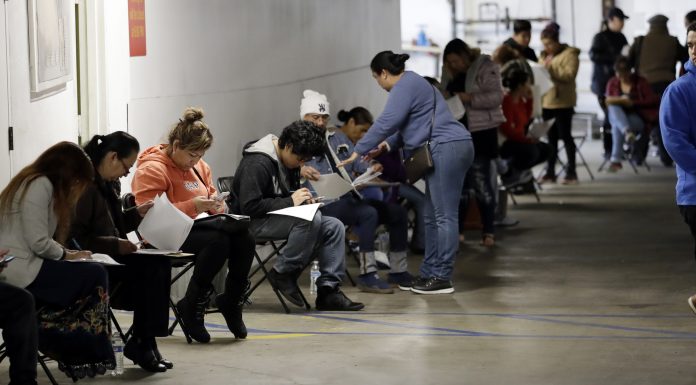(Courthouse News Service) For the first time since March insured unemployment in the U.S. has dropped below 10 percent, according to a weekly report out Thursday from the Department of Labor.
About 1 million Americans filed initial claims for jobless benefits last week while roughly the same number of people stopped receiving benefits.
The federal government typically adjusts raw data to reflect seasonal, predictable changes in the job market, but the new applications for unemployment insurance actually reported by states came in at 821,591 for an unadjusted national insured unemployment rate of 9.5%.
The adjusted rate is 9.9%, down from 10.2% the week prior.
In its Top of the Mind analysis, investment Firm Goldman Sachs reported “states representing 80% of the population have now reimposed restrictions or put reopening on hold.”
From mask mandates to restrictions on going to bars, the investment firm expects sanctions to continue through 2021.
“We expect the virus to remain a constraint on economic activity until we have an effective vaccine that can be produced and distributed in sufficient numbers to limit infections and ultimately achieve herd immunity,” the report forecasts.
Last week, a total of 27 million Americans received jobless benefits.
This figure includes the 10.9 million self-employed and gig workers receiving Pandemic Unemployment Assistance benefits, as well as the 1.4 million people claiming Pandemic Emergency Unemployment Compensation benefits.
The Department of Labor issued a memo on Aug. 17 clarifying that most unemployment benefits are taxable — including the $600 weekly payment that expired at the end of July and the $300 payment enacted by executive order.
President Donald Trump’s Aug. 8 executive order authorizes the Federal Emergency Management Agency to distribute $300 a week to Americans receiving unemployment benefits, plus a $100 contribution from states.
Only 32 states had been enrolled in the program as of Aug. 25.
Many economists considered the unemployment benefits a lifeline for out-of-work Americans during the pandemic.
The Household Pulse Survey from the U.S. Census Bureau showed that about 12% of Americans experienced food scarcity through July 21.
For Black and Latino Americans, that number was higher, about 21% per group.
In total, 29 million adults and 9 million to 17 million children reported not having enough to eat the last week of the survey.
Trouble paying rent or mortgage on time was reported by 21% percent of people polled.
While unemployment rates have slowly declined, the return of jobs is not evenly distributed across the nation.
Unemployment dropped to 0.5% among high-wage earners, according to the Opportunity Insights tracker, but remains at 12.5% for low-wage workers who make less than $27,000 per year as of Aug. 16.
In July, the Bureau of Labor Statistics reported 9.4% of whites are unemployed while the jobless rate remains 14.6% for Black Americans and 12.9% for Hispanics.
Hawaii reported the highest insured unemployment rate in the country (19.8%), followed by Puerto Rico and Nevada, according to Labor Department data.
With about 11,000 new claims for jobless benefits each, Florida and New Jersey reported the highest increases in new claims for jobless benefits while California, Nevada and Georgia reported decreases…Original Source…

